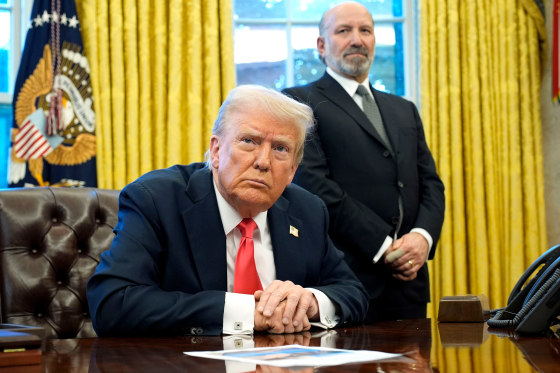Markets remain locked into the slightest developments in President Donald Trump’s tariffs strategy — the result of a vacuum of uncertainty that’s forced investors to try to fill in the blanks.
Stocks surged to their highest levels in more than a week Monday, following weekend reports from Bloomberg and The Wall Street Journal that the president was no longer going to impose blanket duties on industrial sectors like automobiles, pharmaceuticals and semiconductors.
Shares of Tesla, which have been battered by both sluggish sales and a backlash against CEO Elon Musk, soared 9.5% Monday; previously, the company submitted a letter to Trump’s trade representative, Jamieson Greer, stating it was vulnerable to retaliatory tariffs imposed by other countries in response to Trump’s measures.
A source familiar with Trump’s thinking told NBC News early Monday that the president has yet to make a final decision about the ultimate scale of his promised blanket-tariffs, expected to be announced on April 2. Trump delivered further volatility on Monday when he announced on his Truth Social platform that, starting that date, any country that purchases oil or gas from Venezuela would be forced to pay a 25% tariff on any trade they do with the U.S.
Later Monday, Trump hinted at even more leeway in the April 2 duties, while stating other levies on industrial items could still be forthcoming.
“I may give a lot of countries breaks, but it’s reciprocal,” Trump said. “But we might be even nicer than that. You know, we’ve been very nice to a lot of countries for a long time."
He added: "We’ll be announcing some additional tariffs over the next few days, having to do with automobiles, cars and also to do a little with lumber down the road, lumber and chips.”
The president has demonstrated a willingness to relent somewhat on his tariff threats, even as he publicly maintains pressure. Last week, he signaled that when it came to tariffs on China, there was room for “talk,” and that while he was intent on imposing new tit-for-tat duties on longstanding U.S. partners, daylight remained.
“I don’t change. But the word flexibility is an important word,” Trump said in remarks in the Oval Office. “Sometimes it’s flexibility. So there’ll be flexibility, but basically it’s reciprocal.”
Treasury Secretary Scott Bessent also suggested last week that the range of countries targeted by the April 2 duties would likely be more limited than what has previously been reported, telling Fox News Host Maria Bartiromo that a “Dirty 15,” referring to the approximately 15% of nations with persistent trade imbalances with the U.S., would be affected.
In descending order, the nations and entities with the largest trade deficits with the U.S. are China, the E.U., Mexico, Vietnam, Taiwan, Japan, South Korea, Canada and India.
Trump’s ongoing openness to negotiate is why the threatened 25% duties on Mexico and Canada were ultimately suspended, then scaled back to only include goods not covered by the U.S.-Mexico-Canada trade agreement.
Trump also proved receptive to entreaties from major auto firms about how dramatic the impact of the tariffs with America’s northern and southern neighbors would be to their businesses.
The U.K.’s trade minister was set to meet with White House officials to discuss the prospect of a bilateral trade deal focused on technology, Reuters reported last week. Bloomberg said Monday that the E.U.’s trade chief was also expected to meet with White House officials Tuesday.
U.S. officials are also in India this week as part of ongoing trade talks.
And South Korean conglomerate Hyundai was expected to announce a $20 billion investment in U.S. onshoring, including a new steel plant.
Heading into Monday, only steel and aluminum tariffs and higher duties against Chinese goods have gone into effect, despite a host of threats to impose more tariffs.
Whatever its final form, the president’s tariffs strategy continues to cast a pall over economic growth outlooks. S&P Global financial group said Monday that business expectations for the year ahead had fallen to their second lowest since October 2022 in March, “as companies grew increasingly cautious about the economic outlook, often citing worries over customer demand and the impact of aspects of the new administration’s policies.”
A separate S&P Global report said tariffs are now dominating companies’ earnings calls, with the number of references to trade issues climbing to approximately 900 for fourth-quarter discussions.
“The near universal intent to pass through higher tariffs via prices means either inflation will result or, if the pricing environment is more resistant, corporate profit margins will begin to feel pressured,” S&P analysts wrote.
And last week, the Federal Reserve suggested tariff threats were putting upward pressure on price growth, though by what extent was not yet clear. Fed Chair Jerome Powell also said any acceleration in inflation could ultimately prove “transitory” depending on the tariffs’ ultimate scope.

